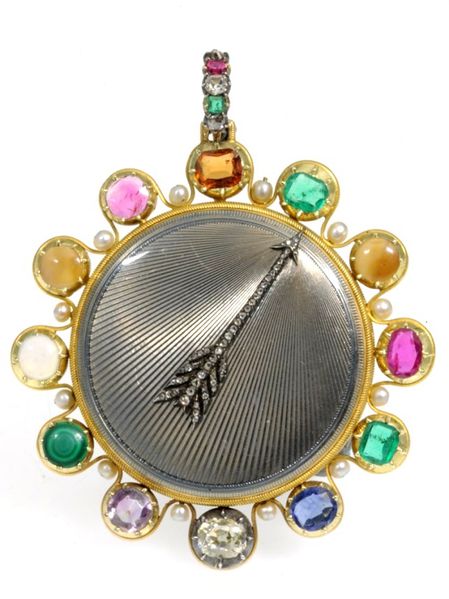Datei:Bazile-Charles Le Roy, Geh. Nr. 2960, Werk Nr. 3082, circa 1800 (1).jpg

Originaldatei (643 × 858 Pixel, Dateigröße: 137 KB, MIME-Typ: image/jpeg)
Bazile-Charles Le Roy - Horloger de S.A.I. et R. Madame à Paris, Geh. Nr. 2960, Werk Nr. 3082, 51 mm, 56 g, circa 1800

|
Alle Bildrechte liegen bei dem Auktionshaus Auktionen Dr. H. Crott. Diese Abbildung ist urheberrechtlich geschützt und steht nicht unter einer freien Lizenz. Für anderweitige Nutzungen außerhalb von Watch-Wiki ist die schriftliche Zustimmung des Urheberrechtsinhabers nötig. |
Hochfeine, seltene, mit großen Edelsteinen, Diamanten und Perlen besetzte Goldemail "Montre Médaillon à Tact" Präsenttaschenuhr des Königs von Westphalen mit versteckter Gravur "Donné par le Roi"
Geh.: 20Kt Gold, Email, Edelsteine, Perlen, auf der Rückseite signiert. Gehäusemacher-Punzzeichen "PBT" (Pierre- Benjamin Tavernier). Ziffbl.: Goldplatine mit kleinem, dezentralem, guillochiertem Zifferblatt mit radialen röm. Zahlen. Werk: "Lepine" Kaliber, Schlüsselaufzug, fliegendes Federhaus, Zylinderhemmung, dreiarmige Messingunruh.
Taverniers "forme collier" Gehäuse, dessen Vorder- und Rückseite mit aufwändig guillochierter Strahlendekoration und transluzid taubenblauem Email dekoriert ist. Der drehbarer Frontdeckel besitzt einen diamantbesetzten Pfeil "sous émail" zum Anzeigen der Stunden. Als Tastknöpfe zum Erfühlen der Zeit ist das guillochierte Mittelteil mit goldgefassten, bunten Edelsteinen, Diamanten und dazwischen sitzenden Perlen besetzt. Die verwendeten Edelsteine sind Hessonite, Emeraude, Uvite, Rhodolite, Emeraude, Saphire, Diamant, Améthyste, Morganite, Opale, Uvite, Rhodolite und ergeben mit den Anfangsbuchstaben ihrer französischen Bezeichnungen den poetischen Ausdruck "HEURES D'AMOUR" . Unter der französischen Kaiserin Marie-Louise kreierte der berühmte Pariser Juwelier Chaumet ein Buch mit Edelsteinen, deren Anfangsbuchstaben das Alphabet ergeben, um auf geheimnisvolle Art einen Namen, einen poetischen Ausdruck oder eine Liebesbotschaft zu schreiben.
A very fine and rare gold and enamel "Montre Médaillon à Tact" studded with large gemstones, diamonds and pearls; a presentation pocket watch from the King of Westphalia with concealed dedication engraving "Donné par le Roi" Case: 20k gold, enamel, gemstones, pearls, signed on the back cover. Case maker's punch mark "PBT" (Pierre- Benjamin Tavernier) Dial: gold plate with a small eccentric engine-turned dial with Roman numerals. Movm.: "Lepine" calibre, keywind, going barrel, cylinder escapement, three-arm brass balance.
"Forme Collier" case by Tavernier. Front and back with lavish radial engine-turned case decoration, translucent powder-blue enamelling, revolving front lid with applied diamond-studded arrow pointer "sous émail" indicating the hours. Engine-turned case band with lustrous, varicoloured gemstone touch studs, diamonds and pearls set in gold. The French names of the gemstones used for the watch are H essonite, Emeraude, Uvite, Rhodolite, Emeraude, Saphire, Diamant, Améthyste, Morganite, Opale, Uvite and Rhodolite - their initial letters spell the secret message "HEURES D'AMOUR". At the time of French Empress Marie-Louise, the famous jeweller Chaumet in Paris created a book of fine gemstones and "rewrote" the alphabet with their initials, so that they could be used to spell out names, poetic words or messages of love.
"Forme Collier" case by Tavernier. Front and back with lavish radial engine-turned case decoration, translucent powder-blue enamelling, revolving front lid with applied diamond-studded arrow pointer "sous émail" indicating the hours. Case band with lustrous, aquamarine touch studs and pearls. "Montre Médaillon à Tact" - Breguet was the first maker to come up with the design for this kind of watch - he sold the first one early in 1799 to Madame Betancourt, the wife of his best friend. He continued producing the watches in different variations, some with quite large touch pieces (like this watch) and some with small ones. The price for these watches that Breguet created for the wealthiest of his customers was between 10,000 and 15,000 francs. This was a truly enormous sum of money in the early 19th century, nevertheless the watches were highly sought after at the time. One of the reasons for their popularity was that at the time it was considered quite unseemly to read the time in public; these expensive pieces made it possible to tell the time without taking the watch out of one’s pocket. Breguet remained almost the only one to create this kind of watch; only Le Roy Horloger de S.A.I et R. Madame à Paris (Bazile-Charles Le Roy (1765-1839)) and very few others followed in his footsteps. Le Roy created a number of timepieces of this type - the most elaborate one for the Prince of Hesse, which had 17k diamond buttons for reading the time in the dark and is now owned by the Patek Philippe Museum in Geneva. The watch was made around 1810; it bears the number 3191 and is decorated with engine-turned pattern and enamel. Our comparable watch, no. 3165, bears the engraved and enamelled dedication "Donné par le Roi" (presented by the king), refering to Jérôme Bonaparte (1784-1860), Napoleon Bonaparte’s
Dateiversionen
Klicke auf einen Zeitpunkt, um diese Version zu laden.
| Version vom | Vorschaubild | Maße | Benutzer | Kommentar | |
|---|---|---|---|---|---|
| aktuell | 12:57, 26. Okt. 2017 |  | 643 × 858 (137 KB) | Andriessen (Diskussion | Beiträge) | Bazile-Charles Le Roy - Horloger de S.A.I. et R. Madame à Paris, Geh. Nr. 2960, Werk Nr. 3082, 51 mm, 56 g, circa 1800 {{Bildrechte U|dem Auktionshaus Auktionen Dr. H. Crott}} {{Kategorie Bildgalerie Uhrenmodelle Leroy, Bazile-Charles}} Hochfeine… |
Du kannst diese Datei nicht überschreiben.
Dateiverwendung
Die folgende Seite verwendet diese Datei:
- Bildgalerie Uhrenmodelle Leroy, Bazile-Charles
- Picture gallery watch models Leroy, Bazile-Charles
- Galería de imagenes de modelos de relojes Leroy, Bazile-Charles
- Afbeeldingen galerij uurwerkmodellen Leroy, Bazile-Charles
- Фотогалерея Модели часов Leroy, Bazile-Charles
- Galleria fotografica di modelli orologi Leroy, Bazile-Charles